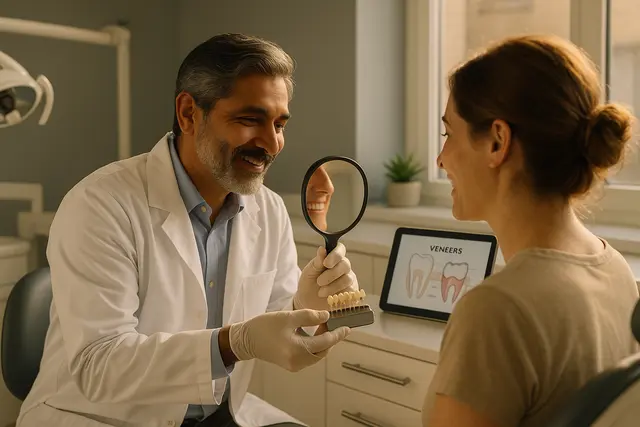Cosmetic Dentistry
8 min read
Mar 21, 2025
Veneers vs. Invisalign: Cosmetic vs. Orthodontic Solutions
Improving your smile often comes down to two main choices: veneers or Invisalign. Each treatment serves a different purpose. Veneers offer a fast way to change the look of your teeth, while Invisalign focuses on aligning your natural teeth over time. The best option depends on your needs, timeline, and budget.

What Exactly Are Veneers?
Selfies don’t lie. If every snapshot makes you wish your teeth looked straighter, brighter, or simply more camera‑friendly, you’ve probably Googled veneer and Invisalign options after midnight. You’re not alone: more than 15 million people have used Invisalign clear aligners, and veneers are a popular cosmetic dentistry staple that seems to pop up on every makeover show.
But which treatment option actually fits your smile, wallet, and lifestyle? Let’s unpack the difference between veneers and Invisalign, minus the dental jargon overload, and see how each path can improve the appearance of your grin.
A veneer is a wafer‑thin facing that slips over the front of a tooth like a designer phone case. Veneers are thin shells sculpted from porcelain or composite resin to mask stains, chips, or gaps. Getting veneers involves shaving a sliver of enamel (think the width of a fingernail clipping), taking impressions, and bonding the custom piece in place.
Because veneers are bonded permanently, they can last a decade or more with solid brushing habits and an occasional night guard. Veneers can be used on a single stubborn incisor or across an entire arch; the best way to determine how many you need is a chat with a dentist who has an eye for symmetry.
Oral Health First: Why Dental Foundations Matter
Most people who chase veneers aren’t fighting complex dental issues like crossbites or severe crowding. They simply want to improve the appearance of their smile in a flash. Veneers can address a wide array of color mismatches and minor size discrepancies, and veneers can also cover small fractures that drive perfectionists crazy.
If you’re considering veneers, remember that veneers require healthy tooth foundations, no rampant decay or angry gums allowed. A thorough dental exam, complete with X‑rays, rules out hidden trouble before any porcelain or composite touches your enamel.
Invisalign 101: How Clear Aligners Move Teeth
Invisalign is an orthodontic treatment, not a cover‑up. Invisalign uses clear, removable trays to nudge teeth into place over months rather than days. Although Invisalign cannot treat every jaw alignment problem, some rotations still need traditional metal braces, the system keeps improving, and Invisalign can help many adults who would rather skip brackets altogether.
Invisalign focuses on gentle, systematic pressure, swapping trays every one to two weeks. The length of Invisalign treatment ranges from six months for mild tweaks to 24 months for more ambitious moves. Average cost of Invisalign sits around $3,500–$7,000, so the cost of Invisalign treatment can be higher than simple whitening but often less expensive than veneers when you total multiple teeth.
A Closer Look at Dental Veneers
Porcelain veneers are thin, luminescent, and wildly durable. Porcelain veneer material resists coffee stains better than natural enamel, and porcelain veneers may last 15 years with proper flossing.
Porcelain veneers can last even longer if you avoid chewing ice or ripping open packages with your front teeth (your dentist cringed just reading that). Thin sheets of porcelain sit flush with neighboring enamel, so nobody spots a step at the gumline, and shells of porcelain or composite blend smoothly with surrounding shade.
Veneers or Invisalign: Which Fixes Your Main Issue?
Choosing between Invisalign and veneers usually boils down to what bugs you more: shape or position. If you hate that one canine sticks out like it’s photobombing every group shot, Invisalign is a clear aligner system that gently tucks it back in line. If your teeth are basically straight but hopelessly yellow or mottled, veneers may be a good route.
Whether Invisalign or veneers depends on your specific goals, your timeline, and your bank account. Veneers can provide nearly immediate results, but Invisalign offers gradual change without grinding down healthy enamel. Deciding between Invisalign and veneers is a very personal call, and a candid chat about priorities helps narrow it down.
Pairing Invisalign and Veneers for a Complete Makeover
Some patients want the best of both worlds: a round of Invisalign treatment to straighten, followed by porcelain or composite facings to perfect color and contour. Invisalign and veneers can help enhance both alignment and shade without escalating to crown work.
Important to note that Invisalign trays may not fit perfectly once veneers are placed, so orthodontists often finish aligner therapy first and then send you back to the cosmetic dentist for the finishing touches. Invisalign and veneers depends on careful coordination, but the combo can deliver magazine‑cover smiles.
Invisalign vs. Veneers: Comparing Results and Timelines
Invisalign uses clear plastic to reposition teeth; veneers are thin sheets of porcelain that camouflage flaws. Invisalign treatment is designed to adjust bite and spacing, while veneers can improve shade and contour overnight.
Veneers can address stubborn discoloration and minor chips; Invisalign can help correct crowding and gaps. Deciding between veneers depends on how quickly you need results and how willing you are to commit to aligner wear.
Veneers vs. Braces: Cosmetic Goals vs. Functional Shifts
Traditional braces still reign supreme for severe skeletal problems and dramatic rotations. Traditional metal braces use fixed brackets and wires to yank teeth into obedience. Metal braces can look intense on Zoom, but they give orthodontists Hulk‑level control.
Invisalign vs braces often comes down to severity: if your ortho says Invisalign is the right choice for your bite, grab the clear trays and thank modern tech. If not, remember that every adult who braved brackets in their thirties agrees it was worth the selfies afterward.
Porcelain Veneers: Ultra‑Thin, Ultra‑Tough
When people say veneers are thin sheets, they’re not exaggerating. Veneers are thin, about 0.3 mm for minimal‑prep styles. Veneers are thin shells, practically contact‑lens slim, yet strong enough to bite pizza crust.
Porcelain or composite decisions hinge on budget and desired longevity; porcelain veneers are thin but pricier, while composite can be shaped chairside and is less expensive than porcelain but prone to stain sooner. Porcelain or composite, each veneer is crafted with the translucency of natural enamel so light bounces convincingly.
Traditional Braces Still Have a Place, Here’s Why
Traditional metal braces can tackle rotations and root movements that clear trays struggle with. Traditional metal braces supply constant pressure and don’t rely on patient compliance. While metal braces can be more noticeable and slightly harder to clean, they often finish complicated cases faster than aligners, especially when rubber bands and auxiliary wires enter the mix.
The Big Picture: Pros and Cons at a Glance
No smile upgrade comes without trade‑offs. Veneers can address stubborn discoloration, close tiny gaps, and create Hollywood symmetry in two to three visits. But veneers depend on irreversible enamel removal, veneers can range from $900 to $2,500 per tooth, and repairs aren’t cheap.
Invisalign offers removable convenience, easier flossing, and no drilling, yet aligners demand 20–22 hours of wear and won’t mask permanent stains. Pros and cons of Invisalign include stealth aesthetics and freedom from wires but also the responsibility of keeping trays in and remembering where you put them after lunch.
Invisalign or Veneers? Use Your Priorities as a Compass
Still torn? Invisalign or porcelain veneers can both boost your confidence, but they solve different puzzles. Invisalign uses clear plastic to fix alignment, while veneers improve color, size, and minor shape hiccups. Expensive than Invisalign on a single‑tooth basis, veneers can help you correct stains instantly. Expensive than veneers for a full‑mouth makeover, Invisalign focuses on repositioning every tooth without removing enamel.
Getting Veneers: Step‑by‑Step
If you wake up dreaming of perfectly even front teeth, get veneers after a professional cleaning so color matching is accurate. Veneers can be used on eight to ten front teeth for a uniform glow, or on just one tooth that never matched its neighbors. Remember that veneers are bonded into place forever, so pick a shade you can live with at 2 a.m. when the fridge light catches your reflection.
Cosmetic Dentistry and the Smile‑Self‑Esteem Connection
Cosmetic dentistry blends artistry with biology. Veneers to your teeth must look natural under café lighting and office fluorescents. A cosmetic dentist with digital design software can show mock‑ups so you’re not surprised by the final color. Veneers can improve contour and harmony, while Invisalign may refine bite forces so restorations last longer.
Who Makes a Strong Candidate for Veneers?
Ideal candidates usually have good enamel thickness, no untreated cavities, and realistic expectations. A candidate for veneers also needs stable bite forces; if you grind at night, your dentist will suggest a night guard. Considering veneers if your bite is off can chip porcelain fast, so an occlusal analysis is key.
Ideal Candidates for Invisalign Treatment
Ideal candidates for invisalign are adults or teens with mild to moderate spacing or crowding. Invisalign offers flexibility for most busy professionals who love the idea of nearly invisible trays. Invisalign cannot treat every severe malocclusion, yet Invisalign is a good option if you’re disciplined enough to wear aligners the required 22 hours daily.
Counting the Cost of Veneers (and Why Prices Vary)
The cost of veneers escalates with artistic skill and lab quality. Custom‑shaded porcelain pieces from master ceramists command higher fees, but porcelain veneers can last far longer than bargain versions. Compared to veneers, composite bonding looks friendly on your savings account but stains sooner; seem that veneers made from premium porcelain age gracefully with just routine cleanings.
Pros and Cons of Invisalign You Should Know
Pros and cons of invisalign include the freedom to eat popcorn and caramel (just pop trays out), but aligners stain if you guzzle coffee while wearing them. Invisalign is a clear aligner that fits modern lifestyles, but trays warp if you sip hot tea. Although Invisalign trays are BPA‑free, they’re still plastic, keep them clean and cool.
Habits That Make Invisalign Work, And Work Fast
Ideal habits for successful Invisalign patients include wearing trays 22 hours daily, swapping on time, and keeping aligners in a sturdy case instead of a napkin. Whether Invisalign or veneers depends on your commitment level; Invisalign focuses on consistency, while veneers are bonded once and done.
Final Smile Check
Invisalign versus veneers is not a cage match, both have a place in modern treatment plans. Whether invisalign or veneers depends on the root cause of your grin grievances. Invisalign uses clear technology to guide teeth; veneers are the most common cosmetic fix for stains and small chips. Million people have used Invisalign because it fits work and weekend life; veneers can also transform color in record time.
If crookedness bothers you most, invisalign can help. If color is king, veneers may be faster. When you’re ready, book a consult: your dentist will map X‑rays, photos, and a digital scan to show how each route will play out. Deciding between invisalign and veneers is easier when you see a 3‑D preview instead of squinting at mirror angles. Whether invisalign or porcelain veneers, the goal is the same, your smile, only better.
What Is the Difference Between Veneers and Invisalign?
Veneers are thin shells of porcelain or composite resin that are bonded to the front of your teeth to instantly improve their appearance, covering issues like stains, chips, or minor misalignment. Invisalign, on the other hand, uses clear aligners to gradually move your teeth into better positions over time. Veneers offer quick cosmetic results, while Invisalign addresses alignment at the root.
Can I Use Veneers and Invisalign Together?
Yes, some patients benefit from using both treatments. Invisalign is often used first to correct alignment, followed by veneers to fine-tune color, shape, or symmetry. However, it's important to finish Invisalign before placing veneers, as the aligners may not fit properly once veneers are bonded.
Which Is More Expensive, Veneers or Invisalign?
The cost depends on your specific needs. Veneers typically cost more per tooth, ranging from $900 to $2,500 each. Invisalign’s total treatment cost generally falls between $3,500 and $7,000 but may be more cost-effective if you're improving your whole smile. A dental consultation can help break down which option gives you the best value for your goals.
Who Makes a Good Candidate for Veneers or Invisalign?
Ideal veneer candidates have healthy teeth and gums, good enamel thickness, and want to improve shape, color, or minor alignment. Invisalign works best for teens or adults with mild to moderate crowding or gaps who can commit to wearing trays 22 hours a day. Your dentist can help determine which option is best based on your smile needs.
Read Next
Related Posts

Cosmetic Dentistry
Looking for a Dentist Who Whitens Teeth? Here’s What to Know First
A brighter smile can do wonders for your confidence, but finding the right dentist who whitens teeth takes more than just a quick Google search. From treatment options to experience and safety measures, there are a few key things you should know before booking that whitening appointment.
3 min read
Sep 10, 2025

Cosmetic Dentistry
What Type of Dentist Does Veneers? Here’s Who to Trust With Your Teeth
Dreaming of a flawless, photo-ready smile? Veneers can be a game-changer, but only if you choose the right expert to apply them. Understanding who’s qualified to handle this cosmetic procedure is key to getting results that look natural and last for years.
5 min read
Sep 08, 2025

Cosmetic Dentistry
Cosmetic Dentistry and Implants: How They Work Together
A confident smile can do wonders for your self-esteem, and modern dentistry offers more ways than ever to achieve it. Whether you're dealing with missing teeth or simply want a brighter, more balanced look, cosmetic dentistry and dental implants provide powerful solutions that work hand-in-hand to restore both function and aesthetics.
5 min read
Sep 05, 2025
Don’t have time to research every dentist around you?
See why 30k+ patients trusted us